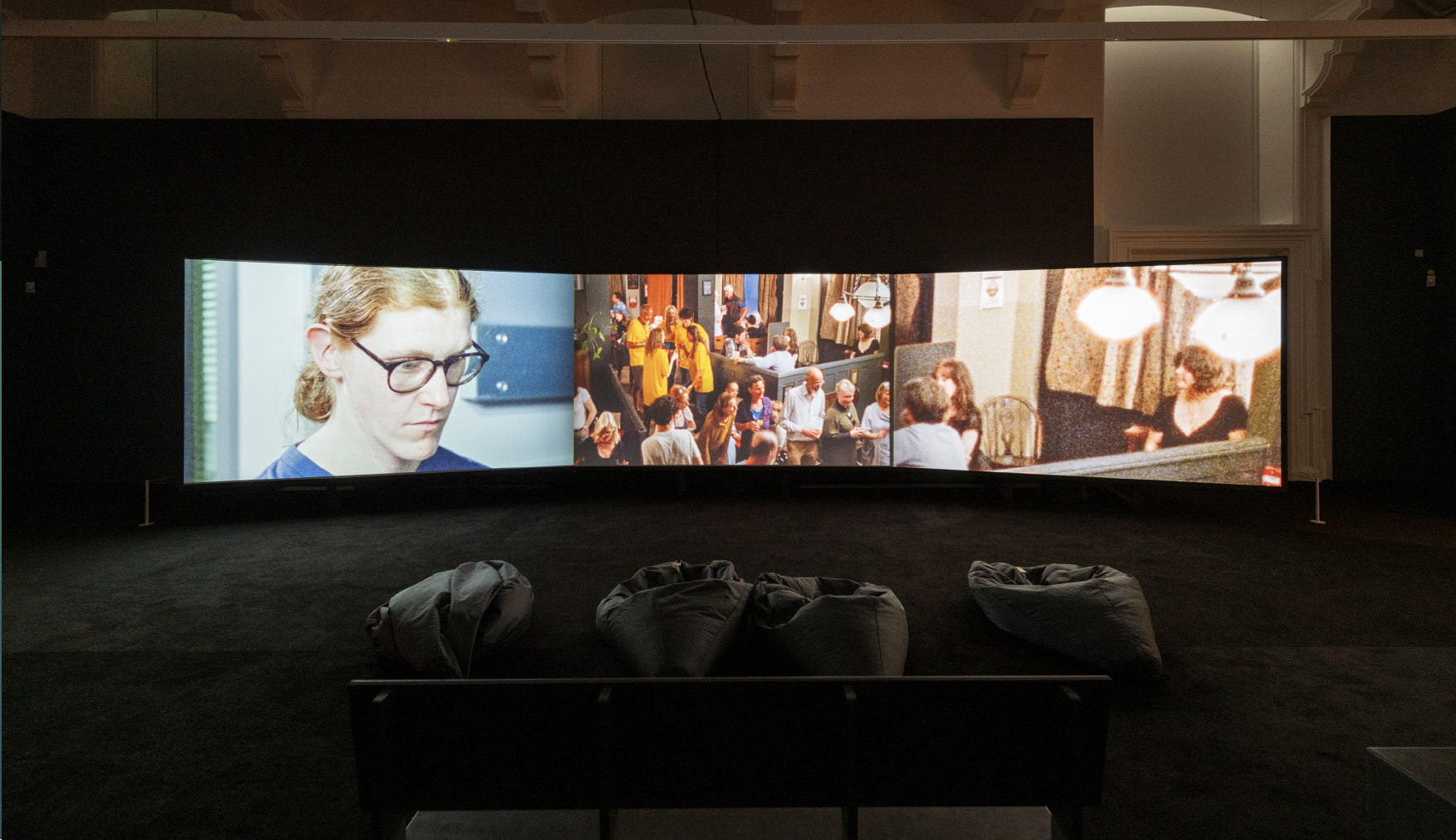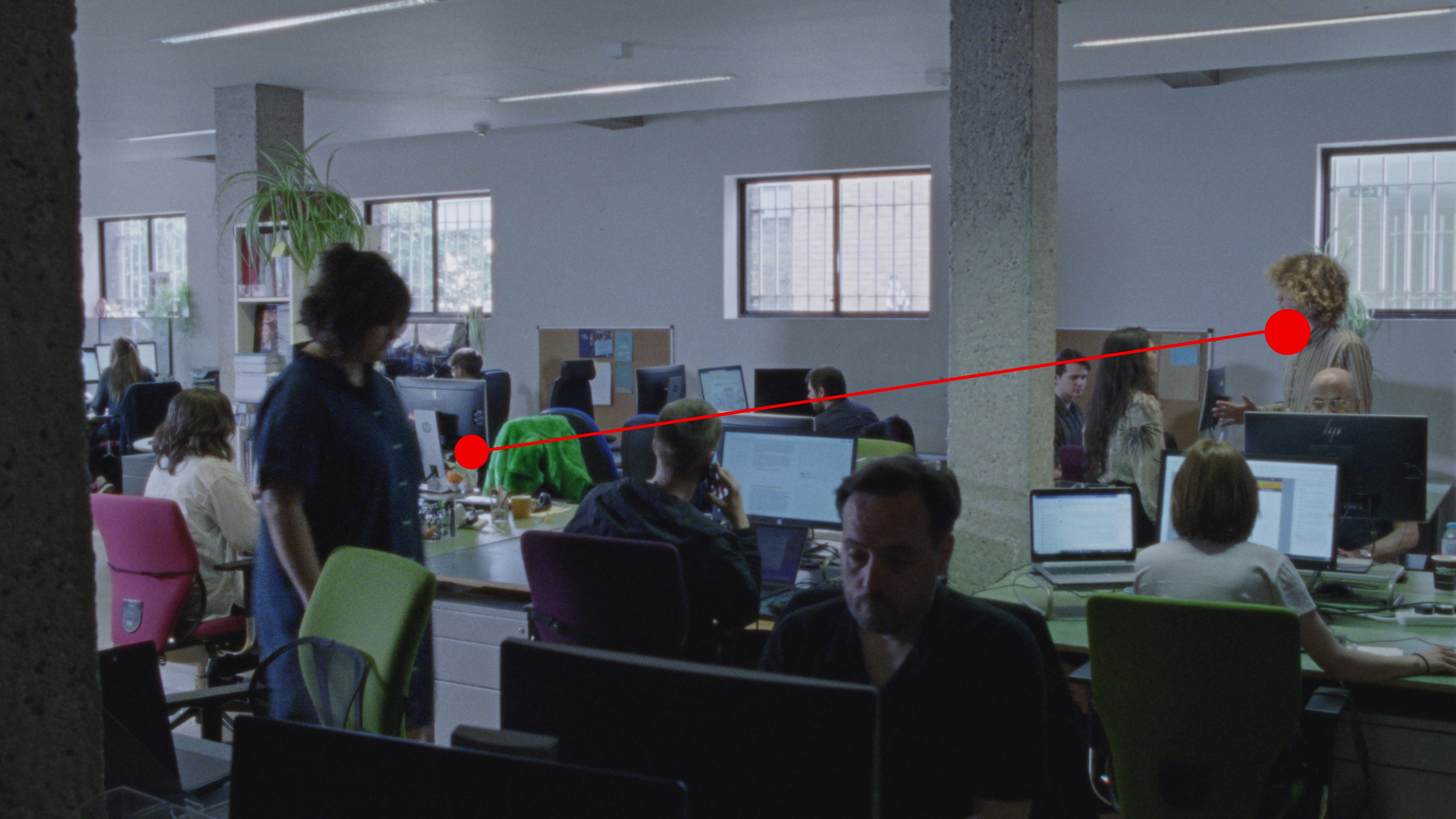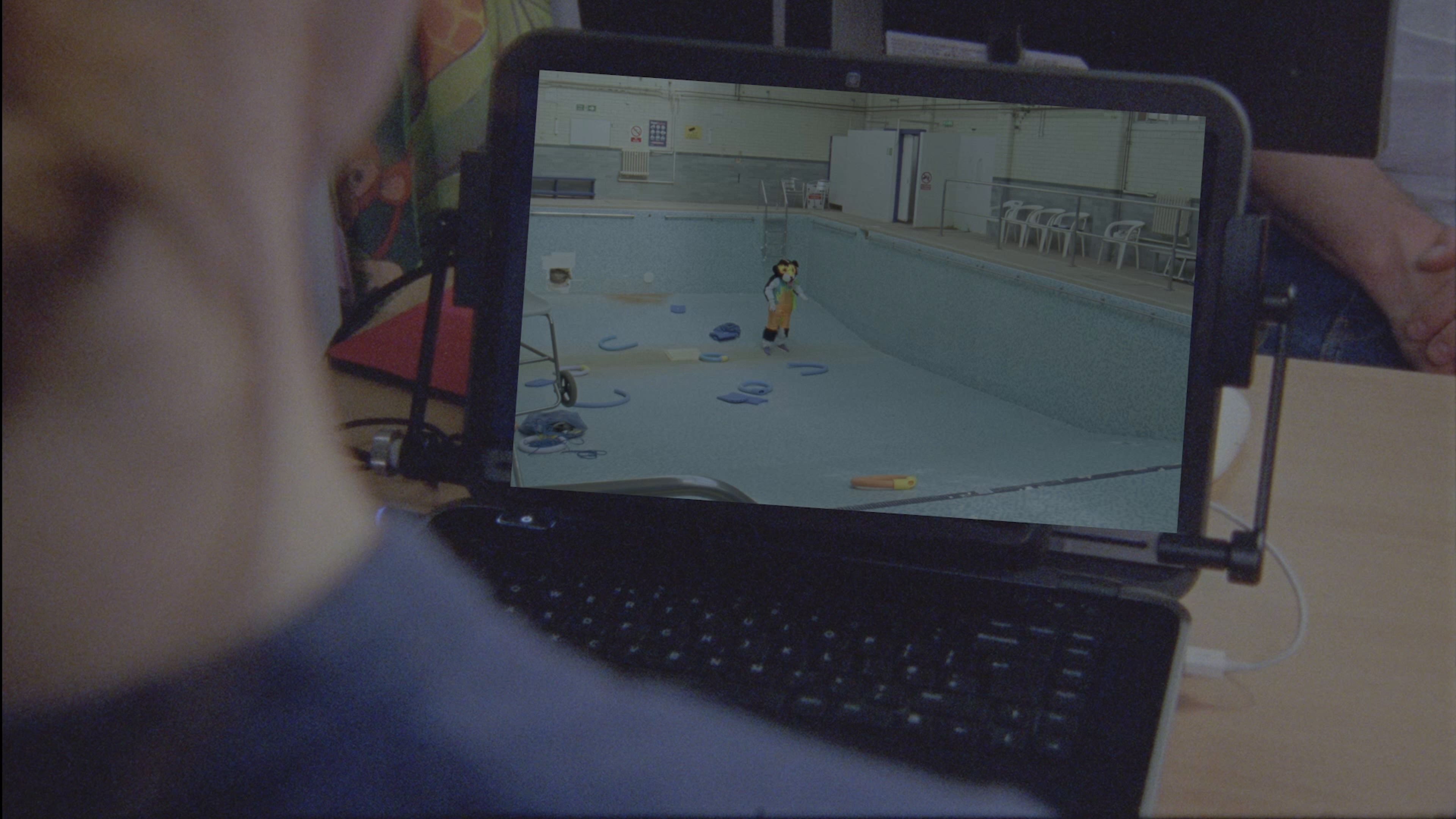Descriptive Audio
The Neurocultures Collective and Steven Eastwood, STIM CINEMA, descriptive audio, 01:50. Delivered by Research and Outreach Assistant Liam Mullen.

Museum & Art Gallery. Courtesy the artists.


Descriptive Audio Transcript
The multi-channel viewing experiences forms a panoramic plane,
causing heads to swivel, and eyes to wander as they wipe across
the screen. Some moments, the images are isolated to one
channel or spread out to form a large continuous picture. In other
cases, there will be three different images—and at times
duplicated, and triplicated perspectives—panning out on each of
the three channels.
The scenes follow a young woman with red hair and large-framed
glasses, as she endures a clinical eye-tracking test guided by a
masculine voice whose body we never see. These trials are used
to arrive at an Autism diagnosis.
Our point-of-view phases between a shared view with the young woman, and that of a clinical bystander. Through the woman’s eyes, we view highly textured vignettes of London’s busy
highstreets, lively pubs, and lush parks, as well as scenes from
nature, such as: branches blowing in the wind. The overlay of the
eye-tracking technology lays atop the video clips: red, circular
nodes tethered to each other, creating an open-ended wireframe.
Additional characters and plots populate the film across various
sites as schisms in the eye-tracking evaluation, recurring
encounters with a woman in a fluffy, Kelly green jacket, and a
cat-like mascot in a teal unitard and mask, emblazoned with
orange flames, and a cascading green cape.
Continuing to move through the gallery in a clockwise direction,
a uniform stack of tabloid-sized pages containing the film’s
transcript is on the floor for visitors to take with them. The stack
of paper stands in the corner at approximately knee height.
Installation Views




STIM CINEMA
Sam Chown Ahern, a visual artist working with drawing, illustration, bookworks, photography and sound. Sam was also the co-host of the CH4 documentary Are You Autistic?;
Lucy Walker, a member of the Project Artworks Collective, working with costume and puppet making, drawing and small set building, all involving alter egos;
Georgia Kumari Bradburn, a short filmmaker whose work focuses on metamorphosis and transformation, and an embodied autistic phenomenology of cinema;
Robin Elliot-Knowles, an associate artist of the Project Artworks Collective, whose practice includes painting, drawing, and graphic-novels, considering themes of intersectionality, post-colonialism, and transgender (Robin is also the curator of the B-Movie Fan Club, a monthly screening at Hastings Electric Palace);
Benjamin Brown, a film programmer/curator whose creative practice involves drawing, video, and photography, with a particular focus on sensory ethnography (Ben also runs a film club called Citizen Autistic).
In 2018, The Blackwood presented Steven Eastwood’s THE INTERVAL AND THE INSTANT in the 5-part exhibition series Take Care, curated by Letters & Handshakes (Greig de Peuter & Christine Shaw). Steven’s participation in Take Care included “The Interval and the Instant: Inscribing Death and Dying,” a conversation with Dr. Naheed Dosani, Dr. Jenny Lau, and Dr. Kim Wedger as part of the the 3-day event Running with Concepts: The Empathic Edition.
In STIM CINEMA, a young woman sits in a clinical setting, taking part in an eye-tracking assessment commonly used in autism diagnoses. During the test, she is shown a series of video clips representing “neurotypical” environments, such as a bustling city street, a shopping mall, and a gymnasium. As the red dots generated by the eye test apparatus trace the subject’s gaze, it becomes clear that these places are filled with naturally occurring repetitive, stim-like actions. Guiding our own gaze to the peripheries of the frame, STIM CINEMA invites us to examine every part of the scene more closely. Flanking the central screen, the left and right present deconstructed views of these scenes that uncover subtle movements and hidden rhythms, bringing attention to the sensory delight found in repetition and stimming.
Throughout the assessment—and unbeknownst to the off-screen facilitator of the eye tracking test—the participant notices a figure in the background of the footage: a young woman in a striking green coat. Drawn to her, a silent connection begins to form. This figure too appears to be quietly negotiating the sensory overload of the neurotypical world. She desires to move with the freedom of a blade of grass swaying the in wind, but feels constrained by the social conventions in spaces like her workplace or a crowded pub. Eventually, she discovers a space of liberation—where both she and the film installation itself are free to stim, sway, and move without restriction.
STIM CINEMA invites viewers into an active, immersive mode of looking—one where delight is found in every corner of the frame, much like a series of spot-the-difference games. Echoing the choreographed ensembles of Jacques Tati and the forensic gaze of Ridley Scott’s Esper machine in Blade Runner, STIM CINEMA embraces a fluid, ever-shifting cinematic form. In doing so, the Neurocultures Collective foreground the aesthetic and sensory pleasures of repetition, pattern, and micro-detail—sensibilities often resonant with autistic perception—while asserting that such modes of attention lie at the very core of moving image itself.
Additional Credits
Associate Artists: Tom Lepora, John Knowles
Produced by Chloe White and Steven Eastwood
Production Manager: Jodie Taylor
On Set Advocacy: Tim Corrigan
Featuring Sam Chown Ahern, Georgia Bradburn, Lucy Walker (as Chess), Sebastian Gaigg
Cinematography: Gregory Oke
Production Design: Nicola Jones
Edited by Sergio Vega Borrego, Steven Eastwood, Christopher Allen (with the Neurocultures Collective)
Sound Design and Mix: Carlos San Juan / Brain Audio
Colour Grade: Jo Barker / Digital Orchard
VFX: Elijah Jona, Adam Clements, Christopher Allen
Zoetrope Rotoscope drawings: Tony Comley
Click to access the Video Transcript and Audio Description

The Blackwood
University of Toronto Mississauga
3359 Mississauga Road
Mississauga, ON L5L 1C6
[email protected]
(905) 828-3789
The galleries are closed for the holidays, reopening Monday, January 5. Regular hours of operation: Monday–Saturday, 12–5pm.
Facebook | Twitter | Instagram
Sign up to receive our newsletter.
The Blackwood is situated on the Territory of the Mississaugas of the Credit, Seneca, and Huron-Wendat.